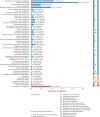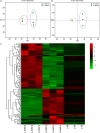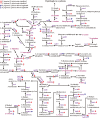Deciphering the Metabolic Pathway Difference Between Saccharopolyspora pogona and Saccharopolyspora spinosa by Comparative Proteomics and Metabonomics
- PMID: 32256469
- PMCID: PMC7093602
- DOI: 10.3389/fmicb.2020.00396
Deciphering the Metabolic Pathway Difference Between Saccharopolyspora pogona and Saccharopolyspora spinosa by Comparative Proteomics and Metabonomics
Abstract
Butenyl-spinosyn, a secondary metabolite produced by Saccharopolyspora pogona, exhibits strong insecticidal activity than spinosyn. However, the low synthesis capacity and unknown metabolic characteristics of butenyl-spinosyn in wild-type S. pogona limit its broad application and metabolic engineering. Here, we showed that S. pogona exhibited increased glucose consumption ability and growth rate compared with S. spinosa, but the production of butenyl-spinosyn was much lower than that of spinosyn. To further elucidate the metabolic mechanism of these different phenotypes, we performed a comparative proteomic and metabolomic study on S. pogona and S. spinosa to identify the change in the abundance levels of proteins and metabolites. We found that the abundance of most proteins and metabolites associated with glucose transport, fatty acid metabolism, tricarboxylic acid cycle, amino acid metabolism, energy metabolism, purine and pyrimidine metabolism, and target product biosynthesis in S. pogona was higher than that in S. spinosa. However, the overall abundance of proteins involved in butenyl-spinosyn biosynthesis was much lower than that of the high-abundance protein chaperonin GroEL, such as the enzymes related to rhamnose synthesis. We speculated that these protein and metabolite abundance changes may be directly responsible for the above phenotypic changes in S. pogona and S. spinosa, especially affecting butenyl-spinosyn biosynthesis. Further studies revealed that the over-expression of the rhamnose synthetic genes and methionine adenosyltransferase gene could effectively improve the production of butenyl-spinosyn by 2.69- and 3.03-fold, respectively, confirming the reliability of this conjecture. This work presents the first comparative proteomics and metabolomics study of S. pogona and S. spinosa, providing new insights into the novel links of phenotypic change and metabolic difference between two strains. The result will be valuable in designing strategies to promote the biosynthesis of butenyl-spinosyn by metabolic engineering.
Keywords: Saccharopolyspora pogona; Saccharopolyspora spinosa; butenyl-spinosyn; comparative proteomic analysis; metK; metabolic pathway; rhamnose synthetic genes; spinosyn.
Copyright © 2020 Rang, He, Yuan, Tang, Liu, Xia, Khan, Hu, Yu, Hu, Sun, Huang, Ding and Xia.
Figures









Similar articles
-
[Effect of fcl gene for butenyl-spinosyn biosynthesis and growth of Saccharopolyspora pogona].Sheng Wu Gong Cheng Xue Bao. 2019 Sep 25;35(9):1662-1675. doi: 10.13345/j.cjb.190142. Sheng Wu Gong Cheng Xue Bao. 2019. PMID: 31559748 Chinese.
-
Identification of a TetR family regulator and a polyketide synthase gene cluster involved in growth development and butenyl-spinosyn biosynthesis of Saccharopolyspora pogona.Appl Microbiol Biotechnol. 2021 Feb;105(4):1519-1533. doi: 10.1007/s00253-021-11105-4. Epub 2021 Jan 23. Appl Microbiol Biotechnol. 2021. PMID: 33484320
-
A TetR family transcriptional regulator, SP_2854 can affect the butenyl-spinosyn biosynthesis by regulating glucose metabolism in Saccharopolyspora pogona.Microb Cell Fact. 2022 May 14;21(1):83. doi: 10.1186/s12934-022-01808-2. Microb Cell Fact. 2022. PMID: 35568948 Free PMC article.
-
Recent advances in the biochemistry of spinosyns.Appl Microbiol Biotechnol. 2009 Feb;82(1):13-23. doi: 10.1007/s00253-008-1784-8. Epub 2008 Dec 10. Appl Microbiol Biotechnol. 2009. PMID: 19082588 Review.
-
Genes for the biosynthesis of spinosyns: applications for yield improvement in Saccharopolyspora spinosa.J Ind Microbiol Biotechnol. 2001 Dec;27(6):399-402. doi: 10.1038/sj.jim.7000180. J Ind Microbiol Biotechnol. 2001. PMID: 11774006 Review.
Cited by
-
Metabolomic profiles of the liquid state fermentation in co-culture of Eurotium amstelodami and Bacillus licheniformis.Front Microbiol. 2023 Jan 26;14:1080743. doi: 10.3389/fmicb.2023.1080743. eCollection 2023. Front Microbiol. 2023. PMID: 36778878 Free PMC article.
-
Mechanistic insight for improving butenyl-spinosyn production through combined ARTP/UV mutagenesis and ribosome engineering in Saccharopolyspora pogona.Front Bioeng Biotechnol. 2024 Jan 15;11:1329859. doi: 10.3389/fbioe.2023.1329859. eCollection 2023. Front Bioeng Biotechnol. 2024. PMID: 38292303 Free PMC article.
-
Bacterioferritin: a key iron storage modulator that affects strain growth and butenyl-spinosyn biosynthesis in Saccharopolyspora pogona.Microb Cell Fact. 2021 Aug 14;20(1):157. doi: 10.1186/s12934-021-01651-x. Microb Cell Fact. 2021. PMID: 34391414 Free PMC article.
-
Endophytic actinobacteria from wild medicinal plants are a natural source of insecticide to control the African cotton leafworm (Spodoptera littoralis).AMB Express. 2023 May 15;13(1):47. doi: 10.1186/s13568-023-01550-x. AMB Express. 2023. PMID: 37184816 Free PMC article.
-
Continuous carbon source supply is essential for high rifamycin productivity of Amycolatopsis mediterranei in nitrate-stimulated fermentation revealed by a metabolomic study.Acta Biochim Biophys Sin (Shanghai). 2025 Jan 23;57(5):738-748. doi: 10.3724/abbs.2024245. Acta Biochim Biophys Sin (Shanghai). 2025. PMID: 39849912 Free PMC article.
References
LinkOut - more resources
Full Text Sources
Research Materials

